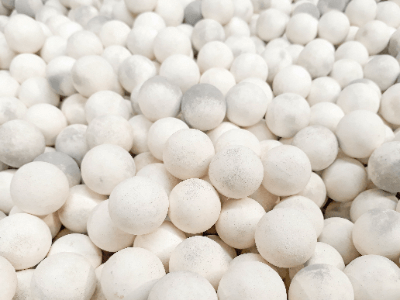What Is an Alumina Ball?

An Alumina Ball is a metallic material used for crushing and dispersing various materials and their resistance to polishing.
When solids are crushed or ground mechanically, it results in unevenness and non-uniformity. Alumina balls are mixed with a hard, spherical object called an alumina ball to ensure uniform grinding. By changing the particle size of the alumina ball, the powder can be ground to a fine powder.
Aluminum, the raw material for alumina, is abundant on the earth and is an inexpensive material to produce.
Uses of Alumina Balls
Alumina Balls are used to grind glass, viscosity, and other materials into a fine powder by placing an appropriately sized Alumina Ball in a mill or other specialized equipment and agitating it. Also, when polishing, the metal surface is polished by putting Alumina Balls and the metal or other materials to be polished together with the polishing slurry and agitating them.
The materials to be agitated, ground, mixed, and polished in the mill range from soft materials such as clay to hard materials such as glass and metal. Alumina Balls are used in a wide variety of applications because they can withstand the high strength and abrasion resistance required of balls that are fed into mills for grinding and polishing.
Principle of Alumina Balls
Alumina Balls are made of aluminum oxide, and their high degree of sophistication is achieved by compacting alumina powder into a spherical shape and then processing it at high temperatures. Because of this high-temperature treatment, they are also called ceramics.
When the Alumina Balls are placed in the mill together with the material to be ground, such as glass fragments, and stirred, the hard Alumina Balls compress and break the glass. The glass fragments gradually become smaller and smaller, and eventually turn into a powder. In the case of grinding, the Alumina Balls are placed in the mill with water and an abrasive, and when stirred, the Alumina Balls rub the metal surface to polish it. Alumina itself is light because of its small density and is chemically stable.
Not only can it withstand high temperatures, but it is also resistant to acids and alkalis and has high wear resistance. Furthermore, since they have no adverse effects on the human body, they are widely used as Alumina Balls for stirring and grinding.
Other Information on Alumina Balls
1. Composition of Alumina Balls
The main ingredient of Alumina Balls is aluminum oxide (Al2O3). However, general-purpose products are sintered by adding a small percent of silicon dioxide (SiO2) or magnesium oxide (MgO) as a sintering aid, in addition to the raw material, alumina powder. As a result, the purity of the product is generally 90-95%. It is this type of general-purpose product that is used for general pulverizing applications.
On the other hand, in the above manufacturing process, silicon dioxide and other materials added to the sintered body are unevenly distributed at the crystal interface (grain boundary), resulting in low strength at the interface and inferior durability and corrosion resistance. High-purity Alumina Balls are made by processing at a high temperature near the melting point of alumina to reduce the amount of sintering aids.
High-purity Alumina Balls have a purity of 99.5% or higher and are superior in hardness and strength, making them suitable for grinding materials that would cause wear with general-purpose balls and for applications where contamination of components other than Al should be avoided. They also have excellent corrosion resistance, making them suitable for applications where corrosion is a concern, such as under strong acidic or alkaline conditions.
2. Comparison of Alumina Balls and Other Ceramic Balls
Alumina Balls are the most common type of ceramic balls that are inexpensive and readily available. However, there are many other types of ceramic balls made of various materials.
Zirconia (ZrO2)
Zirconia balls are made of zirconium oxide and are characterized by higher strength and toughness than Alumina Balls. In addition, zirconia has a high specific gravity, and the impact force generated during the pulverization process is greater than that of Alumina Balls of the same size.
Zirconia balls are used in mechanical milling, a technique that utilizes the energy of pulverization for chemical reactions and material modification.
Silicon nitride (Si3N4)
A material with excellent heat resistance and little strength loss at high temperatures, Si3N4 is used in a wide range of applications, offering a good balance of strength, corrosion resistance, and heat resistance.
Tungsten carbide (WC)
An inorganic compound composed of carbon and tungsten, WC has a Mohs hardness of 9, second only to diamond, and has excellent heat and corrosion resistance. Its extremely high specific gravity makes it suitable for mechanical milling applications due to its high impact force. However, because it is expensive, it is mostly used in research and development.
Tungsten carbide has high hardness, but its toughness is not high, making it susceptible to breakage. Therefore, care must be taken to avoid contamination. Tungsten carbide balls have a few percent of cobalt added as a sintering aid.
Alumina Balls are usually the first choice material because of their strength and properties suitable for general grinding and dispersion applications. However, when special requirements exist, it is important to consider other materials.